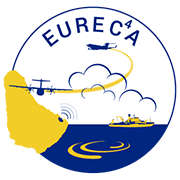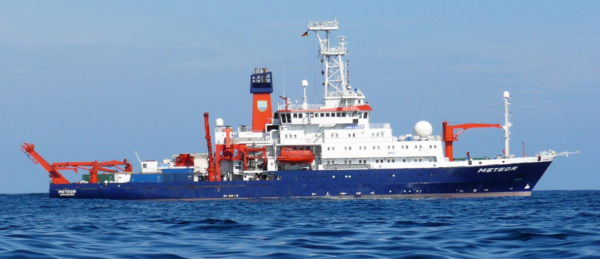Research Vessel Meteor
The R/V Meteor ( schematic) will operate (as part of Cruise M161) eastern (upwind-edge) of the HALO circles. Its main cruise track will consist of a 2-day, wind-perpendicular, race-track patterns across Tradewind Alley (
schematic) will operate (as part of Cruise M161) eastern (upwind-edge) of the HALO circles. Its main cruise track will consist of a 2-day, wind-perpendicular, race-track patterns across Tradewind Alley ( link),with long-legs perpendicular to the mean wind, and short legs closing the loop. The track should take two days, and will consist of 3-hr segments with (i) 2-hr steaming at 8-9 kn; and (ii) station (CTD) work with ship pointed into the wind for 1-hr per station. The track is optimally positioned at the upwind end of the HALO circle. During the period of coordinated operations with the
link),with long-legs perpendicular to the mean wind, and short legs closing the loop. The track should take two days, and will consist of 3-hr segments with (i) 2-hr steaming at 8-9 kn; and (ii) station (CTD) work with ship pointed into the wind for 1-hr per station. The track is optimally positioned at the upwind end of the HALO circle. During the period of coordinated operations with the  R/V Maria S. Merian (MSM) in Tradewind Alley this position may shift to the East (or West). The time on station and ship orientation, as well as the leg-direction for steaming has been determined by accounting for the needs of the surface flux measurements, the oceanographic sounding, the kite and the isotope measurements. Special excursions are planned for CloudKite operations and possible Augonaut/Glider coordination. The extra instrumentation on board was selected to complement atmospheric remote sensing at the
R/V Maria S. Merian (MSM) in Tradewind Alley this position may shift to the East (or West). The time on station and ship orientation, as well as the leg-direction for steaming has been determined by accounting for the needs of the surface flux measurements, the oceanographic sounding, the kite and the isotope measurements. Special excursions are planned for CloudKite operations and possible Augonaut/Glider coordination. The extra instrumentation on board was selected to complement atmospheric remote sensing at the  BCO and by the aircraft. These will add spatial context and improved sampling. The R/V Meteor will arrive in Bridgetown, Barbados at 08:00hr on the 12th of January, 2020 to load and unload instruments. It wil return to sea to be stationed for 4 days upwind of the BCO for instrument installation and calibration, returning to Bridgetown by circumnavigating the Island on 17 January. There it will pick up additional instrumentation from the R/V Maria S Marian and its final crew, deploying in Tradewind Alley on the same day. After the end of the campaign, around 20 February, it will rendezvous with the R/V Maria S Marian before transiting across the Atlantic with an arrival scheduled at Pt. Delgada, Azores, on 3 March, 2020.
BCO and by the aircraft. These will add spatial context and improved sampling. The R/V Meteor will arrive in Bridgetown, Barbados at 08:00hr on the 12th of January, 2020 to load and unload instruments. It wil return to sea to be stationed for 4 days upwind of the BCO for instrument installation and calibration, returning to Bridgetown by circumnavigating the Island on 17 January. There it will pick up additional instrumentation from the R/V Maria S Marian and its final crew, deploying in Tradewind Alley on the same day. After the end of the campaign, around 20 February, it will rendezvous with the R/V Maria S Marian before transiting across the Atlantic with an arrival scheduled at Pt. Delgada, Azores, on 3 March, 2020.
Instrumentation:
| Meteorology & Cameras | Standard instrumentation provides surface in-situ data for temperature, relative humidity, downwelling short and long-wave broadband irradiance, and sea-surface temperature. Cloud camera observations: all-sky visible, narrower field of view thermal (Stefan Kinne MPI-M). |
| Soundings | Six-twelve times daily (minimum) Vaisala RS41-SGP radiosondes measuring pressure, temperature, humidity and GPS position (Claudia Stephan, MPI-M). |
| Microwave cloud radar & radiometer | RPG 94 GHz polarized cloud radar on a stabilized platform provides vertical profiles of reflectivities, doppler velocity, spectral width, linear depolarization ratio, and full Doppler spectra. HATPRO microwave radiometer (MWR) with retrievals of liquid water path and integrated water vapor. Synergistic retrievals with lidar and solar spectrometer provide estimates of cloud droplet number concentration. Within the Cloudnet framework cloud boundaries, hydrometeor classification (including cloud phase), ice water content, and liquid water content are retrieved (Heike Kalesse, U. Leipzig). |
| Solar spectrometer | Downward solar radiance, (300 nm -2200 nm) for droplet effective radius, liquid water path retrievals (Heike Kalesse, U. Leipzig). |
| Raman lidar | 'LICHT' lidar from BCO is similar but lower powered to the new 'CORAL' system at the BCO. On the RV Meteor it will operate on an unstablized platform measuring at three wavelengths (with polarization and near, mid and far-range channels) to provide cloud-base and profiling below clouds and in cloud-free regions of aerosol (concentration, size, shape), temperature and water vapor in the lower troposphere, mostly at night (Ilya Serikov, Ludwig Worbes, MPI-M). |
| Cloud Kite | A kite-stabilized helium balloon for continuous profiling of the sub-cloud layer with high resolution met and other available light instruments for computing flux profiles. In-situ data for cloud profiling (water content, drop size) in lower 1.5 km planned ('Mohsen' Bagheri, Eberhard Bodenschatz MPI-DS). |
| Ceilometer | Jenoptic system, for cloud-base fraction as function of altitude and aerosol backscatter (Stefan Kinne, MPI-M). |
| Sun photometer | Hand-held measurements to calculate daytime (clear sky) AOD (aerosol amount), Angstrom/fine-mode AOD fraction (size) and total atmospheric water vapor (Stefan Kinne, MPI-M). |
| Wind-lidar | Vector winds in the lower atmosphere (Louise Nuijens, U.Delft). |
| Eddy covariance | A 4m outrigger in front of the Meteor and one high up in the main mast close to the operational wind measurements will provide surface momentum, enthalpy and CO2 fluxes (Felix Ament, Uni Hamburg). |
| Stable isotopologues | L2140-i7 Picarro instrument for stable water isotopologue measurements (Joseph Galewsky, U New Mexico). |
| UAVs | Ship-based (quad-copter) UAVs for measuring state properties in lower 400 m. We anticipate additional measurements from a thermal sensor, surface water profiling, and possible particle sizing (with an OPC-N2 measuring over the range 0.38 μm -17 μm, (Szymon Malinowski, U. Warsaw, Piotr Flatau, Scripps). |
| MAX-DOAS | Profiling of SO2, NO2 and O4 (aerosol proxy), HCHO and H2O (Thomas Wagner, MPI-C). |
| Aethelometer & TSI | Aerosol (solar) absorption in seven solar bands and in-situ size (90 nm – 7.5 μm diameter) distribution. (Jacek Piskozub, IOPAN). |
| WRAS | Aerosol in-situ size (5 nm - 32 μm diameter) distribution (Mira Pöhlker, MPI-C). |
| Ocean state | The ship automatically sample ocean surface data on water temperature, salinity and chlorophyll (as a measure for nutrients), as well as wave state and currents. These measurements will be complemented the thermal measurements of SST from the University of Hamburg Outrigger (Felix Ament, Univ Hamburg). |
| Autonaut | Autonomous wave gliders for measuring surface wind velocity, air temperature and humidity, atmospheric pressure, longwave and shortwave downwelling radiation (Karen Heywood, U. E.Anglia). |
| Ocean gliders | Profiles of upper ocean temperature, salinity, solar radiation, chlorophyll fluorescence, dissolved oxygen. These must be recovered by the ship (Karen Heywood, U. E.Anglia). |
| CTD casts | In addition to standard state profiling (temperature, salinity, density, oxygen, fluoresence, turbidity) a bottle measurement system will allow on-station biogeochemical analysis of water masses at different depths will be performed. These include dissolved nutrients (concentrations of macro-nutrients: nitrate/nitrite, ammonium, phosphate, silicate), dissolved gases (CH4, CO2, N2O). Particulate organic carbon, nitrogen and phosphorus will be derived by filtering seawater after the campaign. (Wiebke Mohr, MPI-MB). |
Aquaria/incubators | Two on-deck systems with sea-water flow through.(Wiebke Mohr, MPI-MB) |
PI/Contact:
Stefan Kinne of the MPI-M is the Lead-Scientist (''Fahrtleiter' in German) for the M161 Cruise of the RV Meteor. All general questions should be directed to him. Additional points of contact are Bjorn Stevens (MPI-M, co-lead) or, for instrument specific questions, contact the instrument PIs identified above.
Scientific Crew:
Kinne, Morva-Avalos, Worbes, Baier (MPI-M), Mace (U Utah), Kalesse & Emmanouilidis (U Leipzig), Offermann, Schirmacher (U HH), Schlenczek, Schroeder, Ibanez-Landeta (MPI-DS), Ubele (MPI-C), Los (U. NewMex), Mohr, Kidane, Arx (MPI-MM), Rollo, Siddle (U E.Anglia), Baranowski, Grosz, Chilinski, Nowak, Szkolka (U.Warsaw), Makuch (IOPAN), Andreas Raeke (DWD), TBD1 & TBD2 (CIMH/BDF), deGroot (U Delft), Sandiford (CMIH, Barbados obs), McGeary (BBmet, Barbados obs), Azores obs or Gollop (BDF, Barbados obs)
Installers (12-17 Jan)
Schaefer (U Leipzig), Serikov, Brueggmann (MPI-M), Lenschow (UCAR), Galwesky (U. NewMex), Konemann, Kueger (MPI-C)
Historical Note:
German research vessels with the name Meteor have a history in participating in major atmospheric campaigns over oceanic regions. The first RV Meteor, built in 1915, made pioneering atmospheric and oceanographic surveys of the Atlantic notably von Ficker’s 1936 study of the trade-inversion via upper air soundings. The second RV Meteor, built in 1964, participated in the 1974 multi-platform  GATE campaign over the Atlantic on tropical weather systems. The current Meteor, built in 1986 (pictured above), participated in the 1992/1993 multi-platform
GATE campaign over the Atlantic on tropical weather systems. The current Meteor, built in 1986 (pictured above), participated in the 1992/1993 multi-platform  TOGA/Core campaign on ocean atmosphere coupling in the tropical Pacific. It was the first ship to commit to the
TOGA/Core campaign on ocean atmosphere coupling in the tropical Pacific. It was the first ship to commit to the  EUREC4A campaign in early 2020.
EUREC4A campaign in early 2020.

